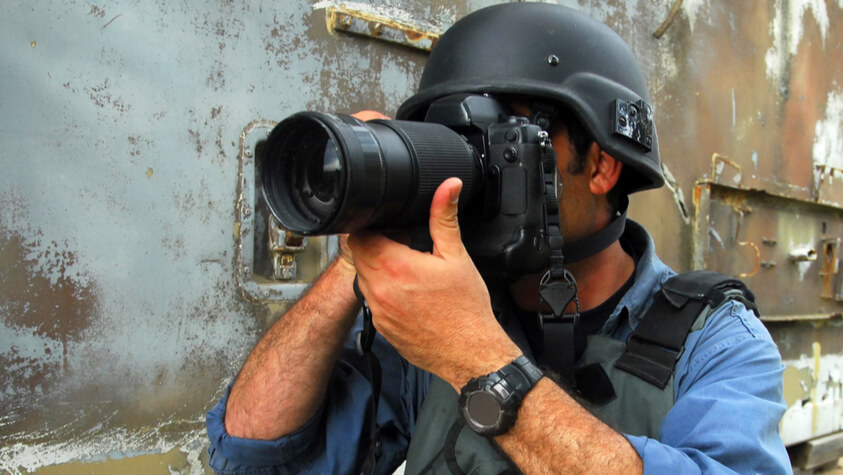By TACP Staff on July 20, 2019

Photojournalists tell stories through pictures. It’s an interesting career where there’s never a dull moment. But, to be successful in this fast-paced world, photojournalists must be knowledgeable about the tools of the trade, be willing to work long hours in unusual conditions and meet tight deadlines, while working independently.
The role of a photojournalist is to tell a story with pictures. Journalist write, photojournalists snap photos. Both fields are important when reporting the news, but as a picture is worth a thousand words, photojournalists have a leg up on most other kinds of media. The US Bureau of Labor Statistics reports a nine-percent decline in photojournalism jobs (Reporters, Correspondents, Broadcast Analysts) between 2014 and 2024. This may be due in part because of the decline in print media; newspapers and magazines. However, as television, websites, blogs, and other online publications grow, so will the need for skilled photojournalists.
Because viewers depend on photos to capture a moment in time, individuals entering this field must have an expert working knowledge of photography equipment, digital software, lighting, editing and color-correcting tools, and more. They must be able to set up a photo or photos, edit the photos without changing the content or significance of the occasion, and upload it to the internet for publication using a variety of software. Beyond technical skills, photojournalists must also have exceptional people skills. Even if a photojournalist works alone, which many do, they must still interact with people while at photo shoots and must conduct themselves professionally.
Photojournalists find themselves in a variety of working conditions, including in the field with a news team, taking pictures of events, or working at photo shoots with companies who employ them. They might work in severe weather and under severe conditions, and sometimes are witnesses to gruesome disasters. Photojournalists work long, often odd hours, weekends and holidays…when news happens. They also often work in high-pressure environments and must strive to meet tight deadlines, and be on call to communicate with others on a breaking news story. In addition, all journalists must understand all legal and ethical issues when using photos, and how to write a contract and diplomatically receive approval prior to publishing a photo.
Most photojournalists earn a bachelor’s degree in journalism, communications, or photography. Some students will major in photography and minor or choose a concentration in journalism, or vice versa. Some employers may hire an applicant who has a degree in a relevant field, such as political science or English. However, employers do look for photography experience no matter the degree field. Photojournalism coursework focuses on shooting photos, learning relevant software programs, digital photography, journalism law and ethics, and training in multimedia. It is also fundamental that photojournalists work across all platforms; social media, online, print, and broadcast.
Because photojournalists often upload photos to the Internet and content is delivered on websites, television, mobile devices, etc., acquiring experience with programming, graphic design software, and coding can’t hurt and may even help your application reach the top of the pile. And, as to how and where people view news and information changes almost daily, photojournalists must also have the ability to develop stories with graphics, data, audio, and video.
Photojournalists can also advance their career by gaining work experience through internships or by working for school newspapers, volunteering for non-profits, or simply by honing their craft through studying new camera techniques, lighting, playing with a different lens, etc.
Although photojournalists tell stories through pictures, there are a number of job duties beyond taking pictures, including processing and printing negatives or film, preparing audio to accompany video segments, traveling to shoot locations, editing photographs, pitching ideas to the editorial staff, writing copy, headlines, and captions to accompany photos and capturing images in an ethical manner.
Photojournalists are skilled artists in their own right. Depending on location, photojournalism jobs may be scarce, and competition can be great. Establishing a network of professionals in similar career fields, such as college professors, reporters, and editors, can help someone just starting out in the field. Building a professional portfolio, filled with pictures of all types, such as people, places and events will give a prospective employer an idea of your talents and capabilities. It’s also important to constantly update your portfolio to show growth and improvement in your photographic skill.
Although the average annual salary for a photojournalist is $42,000, those with little experience can expect to earn much less until they have established themselves and gained a reputation. Individuals with years of experience can earn upwards of $60,000 per year. Photojournalists who choose to freelance may find their salary tends to fluctuate depending on hiring company and workload.

The Art Career Project is a trusted resource for emerging and professional artists.